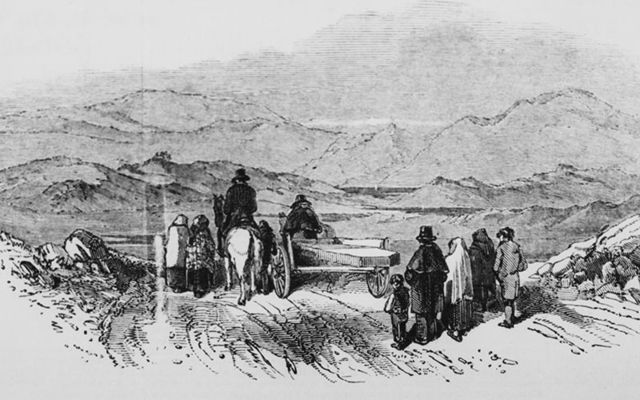"An Gorta Mór" ("The Great Hunger"), a new exhibition at The National Museum of Ireland in Dublin, explores the most difficult year of The Great Irish Famine.
"An Gorta Mór", The Great Hunger or the Great Irish Famine, was a defining episode in modern Irish history during which approximately 1 million people died through starvation and disease with a further 1 million lost through emigration.
The year 1847 is recognized as the most difficult year of the Famine and "An Gorta Mór" showcases a selection of objects from throughout the country that provides an insight into the challenges faced by people living in Ireland during this time.
These include a "griddle" from Offaly that was said to have been used to bake "the black bread", a "loy" from Longford that was used for the cultivation of potato ridges, and a hammer associated with Galway workhouse.
Our #FolkloreFriday is a three legged pot for boiling potatoes. It’s 175 years since Black ’47 when hunger ravaged the island. Before the Famine a landless labourer could consume up to 14 pounds of potatoes a day. This dependence on one food source would prove fatal for many. pic.twitter.com/jrYHkrH2ii
— National Museum of Ireland (@NMIreland) March 25, 2022
Read more
Minister for Tourism, Culture, Arts, Gaeltacht, Sport and Media Catherine Martin, has launched "An Gorta Mór", a new National Museum of Ireland exhibit acknowledging the 175th anniversary of 1847 or “Black ‘47” at the National Museum of Ireland – Decorative Arts & History, Collins Barracks, in Dublin.
Speaking about the exhibition, Minister Martin commented, “We tend to use the word ‘pivotal’ often when describing Irish history. However, apart from the events that founded the modern Irish state, very few events have changed the very landscape of our island so much as The Great Famine. It left a mark on our landscape, our culture, and our collective imaginations.”
“I commend the National Museum of Ireland– Decorative Arts & History, Collins Barracks, for ensuring this important time in our history is represented in our national museum and I look forward to the more detailed gallery to follow.”
Lynn Scarff, Director of the National Museum of Ireland, said, “A challenge in telling this story in a museum context is the relative lack of material culture pertaining to this period. The nature of the Famine and those it predominantly affected has meant that many who perished, had little in the way of material goods remaining to tell their story. Those who could emigrate, by necessity, sold what they might have possessed or took personal belongings with them.”
“Despite this challenge, the National Museum of Ireland is very pleased to open An Gorta Mór. We continue to explore appropriate and engaging ways to tell the story of this most tragic yet important period of Irish history and look forward to expanding our Famine exhibitions through the second phase of our History of Ireland Galleries which will explore 1600 - 1900 in the future.”

Love Irish history? Share your favorite stories with other history buffs in the IrishCentral History Facebook group.




Comments